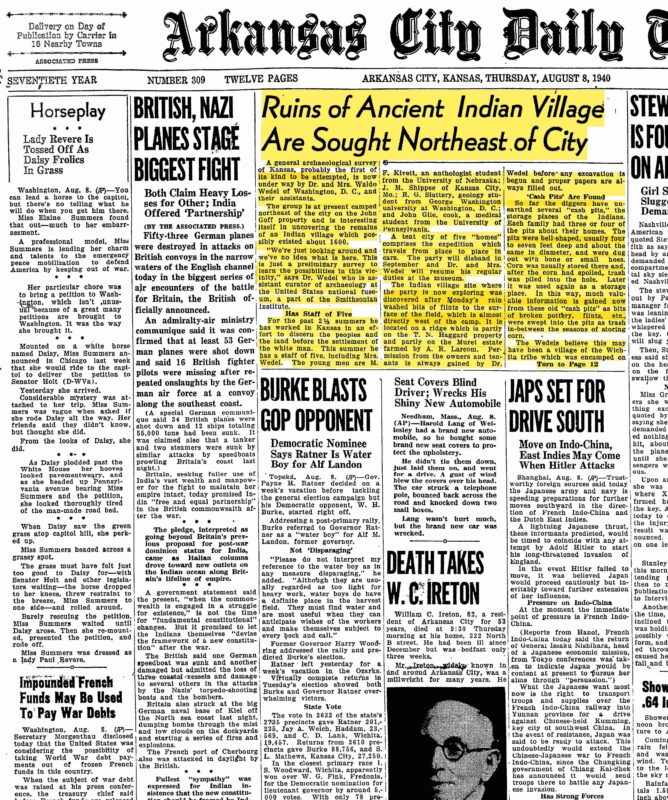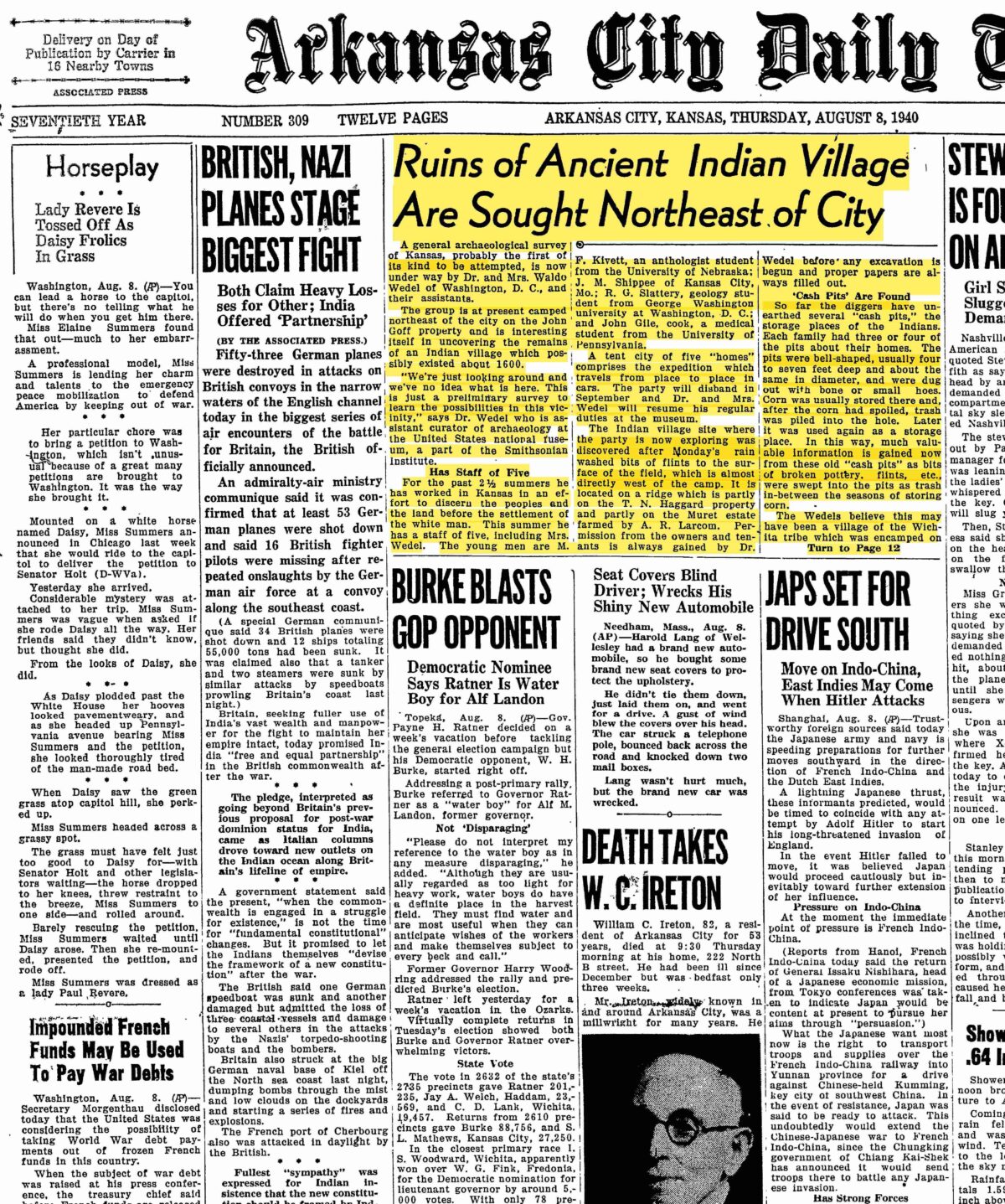Arkansas City Daily Traveler 08/08/1940


Transcript
Ruins of Ancient Indian Village Are Sought Northeast of City
A general archaeological survey of Kansas, probably the first of its kind to be attempted, is now under way by Dr. and Mrs. Waldo Wedel of Washington, D. C., and their assistants.
The group is at present camped northeast of the city on the John Goff property and is interesting itself in uncovering the remains of an Indian village which possibly existed about 1600.
“We’re just looking around and we’ve no idea what is here. This is just a preliminary survey to learn the possibilities in this vicinity,” says Dr. Wedel who is assistant curator of archaeology at the United States national [m]useum, a part of the Smithsonian Institute.
Has Staff of Five
For the past 2 ½ summers he has worked in Kansas in an effort to discern the peoples and the land before the settlement of the white man. This summer he has a staff of five, including Mrs. Wedel. The young men are M. F. Kivett, an anthologist student from the University of Nebraska; J. M. Shippee of Kansas City, Mo.; R. G. Slattery, geology student form Georg Washington university at Washington, D. C.; and John Gile, cook, a medical student from the University of Pennsylvania.
A tent city of five “homes” comprises the expedition which travels from place to place in cars. The party will disband in September and Dr. and Mrs. Wedel will resume his regular duties at the museum.
The Indian village site where the party is now exploring was discovered after Monday’s rain washed bits of flints to the surface of the field, which is almost directly west of the camp. It is located on a ridge which is partly on the T. N. Haggard property and partly on the Muret estate farmed by A. T. Larcom. Permission from the owners and tenants is always gained by Dr. Wedel before any excavation is begun and proper papers are always filled out.
‘Cash Pits’ Are Found
So far the diggers have unearthed several “cash pits,” the storage places of the Indians. Each family had three or four of the pits about their homes. The pits were bell-shaped, usually four to seven feet deep and about the same in diameter, and were dug out with bone or small hoes. Corn was usually stored there and, after the corn had spoiled, trash was piled into the hole. Later it was used again as a storage place. In this way, much valuable information is gained now from these old “cash pits” as bits of broke pottery, flints, etc., were swept into the pits as trash in-between the seasons of storing corn.
The Wedels believe this may have been a village of the Wichita tribe which was encamped on
Turn to Page 12
Ruins of Old Indian Town Sought Here
Continued From Page One
the Arkansas river. Dr. Wedel says there is evidence that the river at that time, 300 to 350 years ago, curved and probably went close to the site of the village.
No home sites have been found, probably because the Wichitas lived in grass huts whose foundations were not substantial enough to have survived the elements. The tribe was evidently in contact with other tribes as pieces of t[ur]quoise, pottery and glass has been found, all evidences of trade with tribes of New Mexico and the Yellowstone.
Dr. Wedel mentions that no indications have been found of horses, which meant that the Indians probably went everywhere on, foot. During that era, the Indians lived mainly by farming and gardening with probably an acre or so allot[t]ed to each family for corn. Meat was supplied by buffalo and wild game.
Mounds at Country Club
There are several Indian mounds about this vicinity that have never been opened, the Wedels reveal. For instance, there are two or three at the Country club, south of the clubhouse. They are about 40 feet across and Dr. Wedel says they should be opened by someone who knows how. But he doesn’t think that his group will have the time.
Before coming to Arkansas City, the party was located near Geneseo, in Rice county, for seven weeks. They worked three villages there, probably belonging to ancestors or descend[a]nts of the same Wichita tribe which was located in the Arkansas City area. They found the usual run of beads, flint drills, bone work and also some evidence of contact with white men, such as iron and glass beads.
This business of archae[o]logy Is not all digging although the digging generally occupies about eight hours a day, from 7 a. m. to 4:30 p. m. Much of the “hard” work is done after the exploration is concluded.
Digging Easiest Task
“The digging is the easiest and most interesting of all,” comments Dr. Wedel, who is a native Kansan having been reared at Newton. “After the day’s digging has been concluded, every piece that has been found, no matter how large or small, has to be classified, the number entered in a catalog to later be checked In Washington when we return there.”
Mrs. Wedel has one of the most tedious tasks. She does a majority of the piecing together of the pottery into its original articles, such as vases, jugs, molds, etc. For the glueing, she uses ordinary household cement and, would you believe it, she uses ordinary nail polish remover to remove the excess glue or take any pieces apart. This polish remover is an expensive form of acetone.
The Wedels have received much of their information about Indian lore and relics from local persons who are interested in such work. They are appreciative of this information, they declare.
End Transcript

